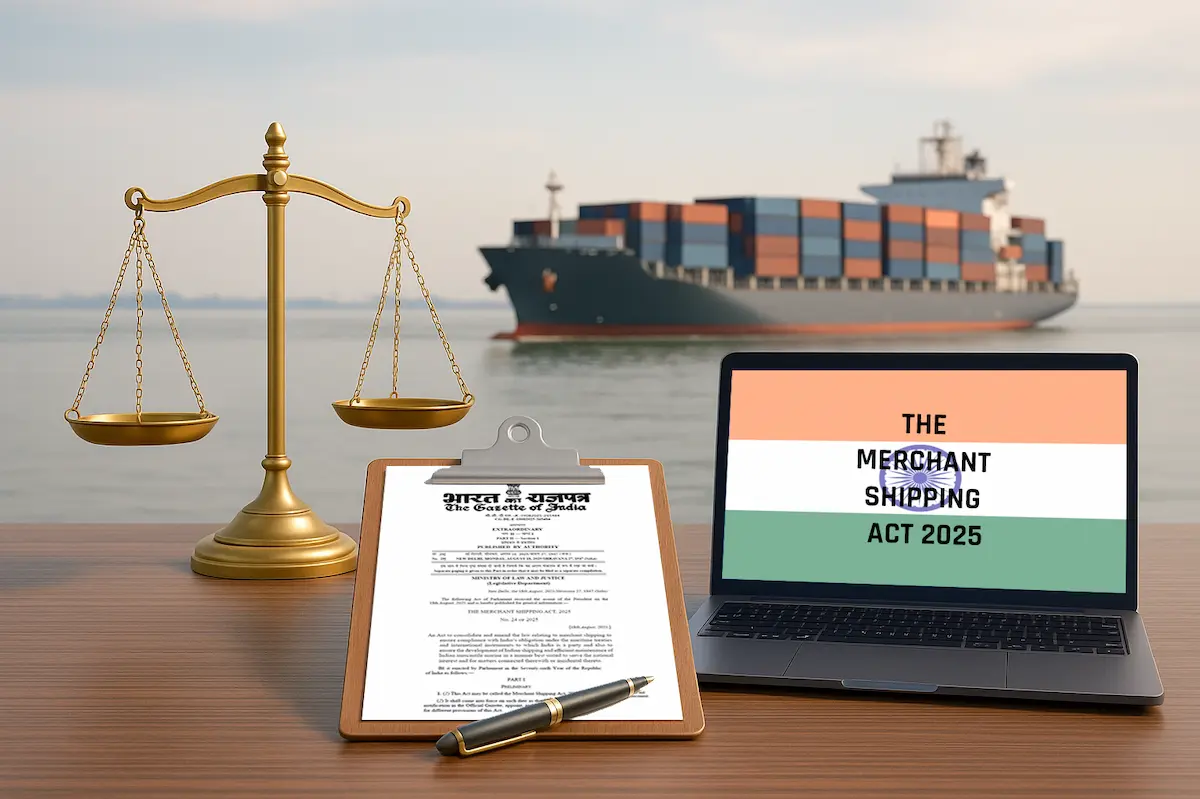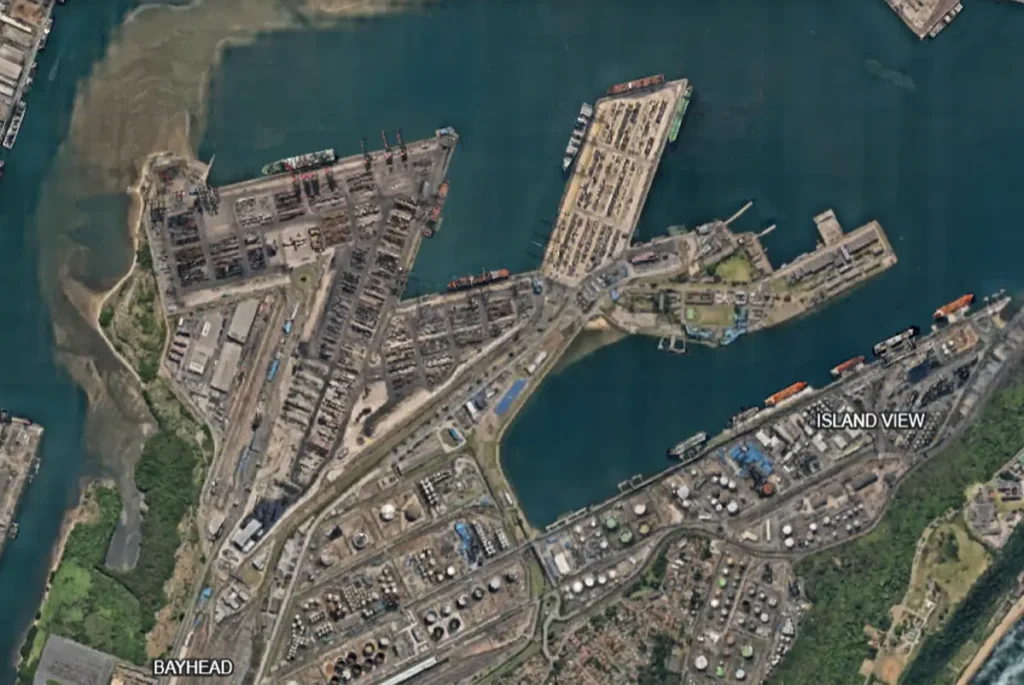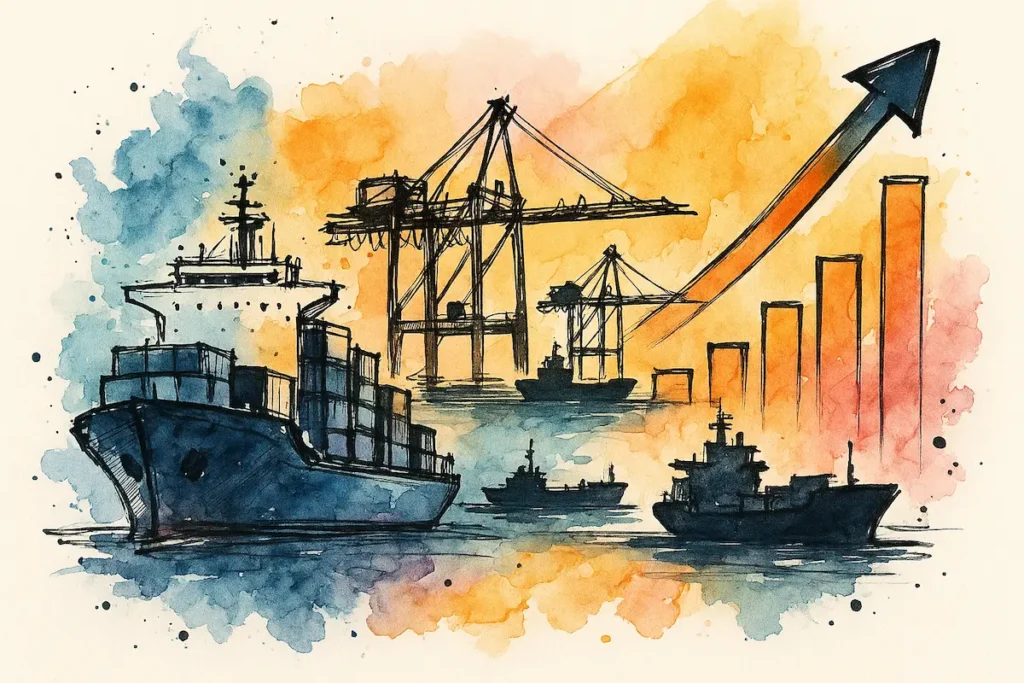On 18 August 2025, the Merchant Shipping Act, 2025 received the President’s assent, replacing the Merchant Shipping Act, 1958 after nearly seven decades..
The Merchant Shipping Bill was passed by both Houses of Parliament – Lok Sabha on the 6th of August 2025 and Rajya Sabha on the 11th of August 2025, paving the way for the President’s assent..
This was published in the Gazette of India, Extraordinary, Part II, Section 1, No. 29, under reference सी.जी.-डी.एल.-अ.-19082025-265484 / CG-DL-E-19082025-265484..
This marks one of the most significant overhauls of India’s maritime regulatory framework in recent history, aligning domestic shipping law with contemporary global standards and practices..
Why a new Act was needed
The 1958 Act served India well for decades, but it was drafted in a very different trade environment.. Back then:
- Containerisation was in its infancy
- Digital records were unheard of
- Compliance, safety, and sustainability standards were less stringent globally
Fast forward to 2025, India is positioning itself as a global maritime power, aiming to modernise laws to match international standards, attract investment, and build resilience in trade operations..
The 2025 Act addresses these by streamlining governance, aligning with international conventions, and introducing reforms to make Indian shipping more competitive..
Key reforms and changes
Some of the headline changes introduced in the 2025 Act include:
- Maritime safety and environmental standards: Updates to align with IMO conventions, with stricter compliance on pollution prevention, vessel recycling, and carbon efficiency..
- Seafarer welfare: Enhanced provisions for training, certification, and social security measures for Indian seafarers..
- Coastal and inland shipping: A clearer legal framework to promote domestic coastal trade and multimodal integration..
- Maritime development fund: Establishment of financial mechanisms to support ship acquisition, innovation, and infrastructure..
- Digitalisation of shipping: Explicit recognition of electronic records under the Act, opening the path to digital documentation and e-governance..
Freight cost transparency – a first for India
One of the interesting provisions is Clause 317..
– Advertise here –
It allows the Central Government, through notification, to require service providers or agents handling Indian or coastal vessels to specify all charges in the bill of lading or transport document..
• These charges must include both fixed and conditional elements..
• No additional charges can be levied later that are not specified upfront..
• Violations can attract penalties of up to INR 5 lakh..
This provision, once notified, could have a major impact on coastal and domestic shipments, improving transparency for exporters, importers, and logistics service providers who have often faced “hidden” or unpredictable costs..
It does not automatically mean that all coastal bills of lading must now be freighted, but it does set the stage for the government to impose that requirement when it sees fit..
The electronic records provision – does this mean electronic bills of lading (eBLs)..??
The Act also contains a clause on “use and maintenance of electronic records,” which states that any record, register, return, or document under the Act may be issued or maintained in electronic form, subject to safeguards and authenticity conditions to be prescribed by the government..
This is a crucial step because it opens the legal door for electronic bills of lading (eBLs) in India.. My interpretation of this clause concerning eBL and MLETR is that :
- The Act provides the enabling framework, but the Central Government must issue specific notifications and rules to operationalise eBLs.. Until then, parties cannot rely solely on an eBL under Indian law..
- This approach aligns India conceptually with UNCITRAL’s Model Law on Electronic Transferable Records (MLETR) and global digital trade standards, but the implementation still hinges on government action..
In other words, India has taken the legislative step to support eBL adoption, but the full green light will only come once the detailed standards and notifications are issued..
India’s MLETR journey – still at Stage 2
It is worth noting that while the Merchant Shipping Act, 2025, represents an important advance, India is formally still at Stage 2 of MLETR adoption as per the MLETR tracker..
This means that the country has created an enabling legislative environment by recognising electronic records, but has not yet fully operationalised transferable electronic documents such as eBLs under a binding, interoperable legal framework..
Other economies such as Singapore, the UK, and recently France have moved to adoption or alignment with MLETR, while India’s progress shows intent but awaits regulatory execution..
For businesses, this distinction matters: the legal foundation is in place, but practical use of eBLs in trade finance, customs, and banking transactions will only become a reality once implementing rules and standards are notified..
What it means for Indian business and trade
For Indian trade and traders, the Merchant Shipping Act, 2025, has several implications:
- Greater predictability in costs: If Clause 317 is notified, businesses can budget freight and ancillary charges with more certainty, reducing invoice disputes and improving cash flow planning for domestic trade..
- Faster digital adoption: The recognition of electronic records lays the groundwork for digital bills of lading, e-certificates, and eventually fully digitalised trade corridors..
- Enhanced competitiveness: With better-aligned global standards, Indian shipping companies may find it easier to integrate with international supply chains..
- Improved seafarer conditions: Indian seafarers, who form a major part of the global workforce, will benefit from stronger welfare, training, and certification provisions..
- Compliance and accountability: Stricter provisions on safety, environment, and transparency mean businesses will need to strengthen compliance mechanisms..
A future-ready step, with implementation pending
The Merchant Shipping Act, 2025, is a landmark reform that modernises India’s maritime sector and signals India’s intent to be a serious player in global shipping and trade..
However, it is equally important to note that many of its most impactful provisions – from freight cost transparency to digital bills of lading – require government notifications to take effect.
Until those are issued, the Act represents a promise of change more than an immediate transformation..
For businesses, the message is clear: start preparing for a more transparent, digital, and internationally aligned maritime regime..
The sooner companies adapt their systems and processes, the smoother their transition will be when the government brings these provisions into force..














